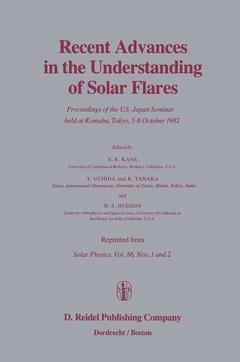Description
Recent Advances in the Understanding of Solar Flares, Softcover reprint of the original 1st ed. 1983
Proceedings of the U.S.-Japan Seminar held at Komaba, Tokyo, 5-8 October 1982
Coordinators: Kane S.R., Uchida Yutaka, Tanaka K., Hudson Hugh S.
Language: English
Subjects for Recent Advances in the Understanding of Solar Flares:
Keywords
Chromosphere; Corona; Solar flare; Variation; solar; solar activity
Publication date: 10-2013
468 p. · 17x24.4 cm · Paperback
468 p. · 17x24.4 cm · Paperback
Description
/li>Contents
/li>
These Proceedings result from the papers and discussions of the U.S.-Japan Seminar "Recent Advances in the Understanding of Solar Flares" held in Tokyo October 5-8, 1982. The meeting was sponsored jointly by the Japan Society for the Promotion of Science and the u.S. National Science Foundation. The principal aim of the meeting was to obtain the most up-to-date physical picture of solar flares by bringing together results from the recent observations by the Solar Maximum Mission (SMM) and HINOTORI satellites, together with other satellite data and ground-based data at both optical and radio wavelengths. These data cover the recent maximum of the solar activity cycle. The SMM and HINOTORI introduced a new dimension in flare observations by carrying out the first hard X-ray imaging observations, and the organizers especially felt that an intense discussion of the significance of these results in the context of flare theories would be important. Starting with an introductory presentation of the characteristics of the instruments on board the satellites, the sessions of the first day and the beginning of the second dealt mainly with energy transport in flares and with .the formation process of the hot plasma which is .
I. Spacecraft with Major Solar Instrumentation.- to HINOTORI.- The Solar Maximum Mission (reference only).- Solar Instruments aboard the P78-1 Satellite.- II. General Characteristics of Flares.- Development of Flare Morphology in X-Rays, and the Flare Scenario.- Magnetic Theories of Solar Flares.- III. Energy Transport, Chromospheric Heating and Evaporation.- Solar Flare X-Ray Spectra from the P78-1 Spacecraft.- Non-Thermal and Non-Equilibrium Effects in Soft X-Ray Flare Spectra.- Observation of Chromospheric Evaporation during the Solar Maximum Mission.- Transport and Containment of Plasmas, Particles, and Energy within Flares.- Interpretation of the Soft X-Ray Spectra from HINOTORI.- Polarization Measurements Using the Bragg Crystal Spectrometers on HINOTORI.- Thermal Evolution of Flare Plasmas.- Conductive Heat Flux in the Chromosphere Derived from Line Linear Polarization Observation.- Upper Limits on the Total Radiant Energy of Solar Flares.- IV. Energy Transport, Chromospheric Heating and Evaporation.- Energetic Electrons as an Energy Transport Mechanism in Solar Flares.- Hydrodynamics of Flaring Loops: SMM Observations and Numerical Simulations.- Behavior of Transition-Region Lines during Impulsive Solar Flares.- The Optical Flare.- Observation of the Flare of 12 June 1982 by Norikura Coronagraph and HINOTORI.- Observations of a Compact Flare on 1981, September 7, in Ha, X-Ray, and Microwave Radiations (Extended Abstract).- The Height of Ha Flare Emitting Region (Extended Abstract).- Positional Measurements on the Eruptive Prominence of 27 April and Comparison with the X-Ray Sources.- V. Emission Processes and Source Structure.- Spatial Characteristics of Microwave Bursts.- Dual Frequency Observations of Flares with the VLA.- Dissipative Thermal Models for Impulsive Burst Delays.- Late Phase Gradual Enhancements in Microwaves and Hard X-Rays of the 6 November, 1980 Flare.- Short-Period Pulsations Observed Simultaneously by X-Ray and Radio Waves (Abstract).- Fast Transients in Hard X-Ray Solar Flares (Abstract).- Hard X-Ray Dynamic Spectra Observed by HINOTORI.- A Flare Model Deduced from HINOTORI and Millimeterwave Interferometer Observations.- Relation between Hard X-Ray Spectra and Electron Energy Spectra.- A Comparison of High-Energy Events in the Quiet Sun with Solar Flares.- Pre- and Post-Flare X-Ray Variations in Active Regions.- Imaging of Impulsive Solar Flare Phenomena.- Temperature Structure of Spatially Resolved Hard X-Ray Flares.- General Aspects of Hard X-Ray Flares Observed by HINOTORI: Gradual Burst and Impulsive Burst.- Vertical Structure of Hard X-Ray Flares.- Hard X-Ray Images of Impulsive Bursts.- Time Variations of Hard X-Ray Bursts Observed with the Solar Hard X-Ray Telescope aboard HINOTORI (with a movie).- Computed Magnetic Field Structure of the Flares Observed by HINOTORI Hard X-Ray Telescope.- Dynamical Interpretation of the Very Hot Region Appearing at the Top of a Loop.- VI. High Energy Photons, Nuclear Processes, and Particle Acceleration.- Spatial Structure of High Energy Photon Sources.- Observations of Fine Time Structures in Solar Flare Hard X-Ray Bursts.- Gamma-Ray Observations from HINOTORI.- High Energy Particle Acceleration in Solar Flares — Observational Aspects.- Gamma-Ray Lines and Neutrons from Solar Flares.- Characteristics of Gamma-Ray Line Flares as Observed in Hard X-Ray Emissions and Other Phenomena.- Narrow-Band Decimeter Bursts and X-Ray Emissions — Possible Evidence of Negative Absorption or Maser Effect.- Particle Acceleration in the 1981, April 1, Flare.- VII. Open Discussion of Controversial Points.- The Stages of Particle Acceleration.- Location of X-Ray and Microwave Sources.- Is the Electron Distribution Thermal or Nonthermal?.- Mass Transport and the Interaction of Loops.- Conference Summary.
© 2024 LAVOISIER S.A.S.
These books may interest you

Energetic Phenomena on the Sun 210.99 €



